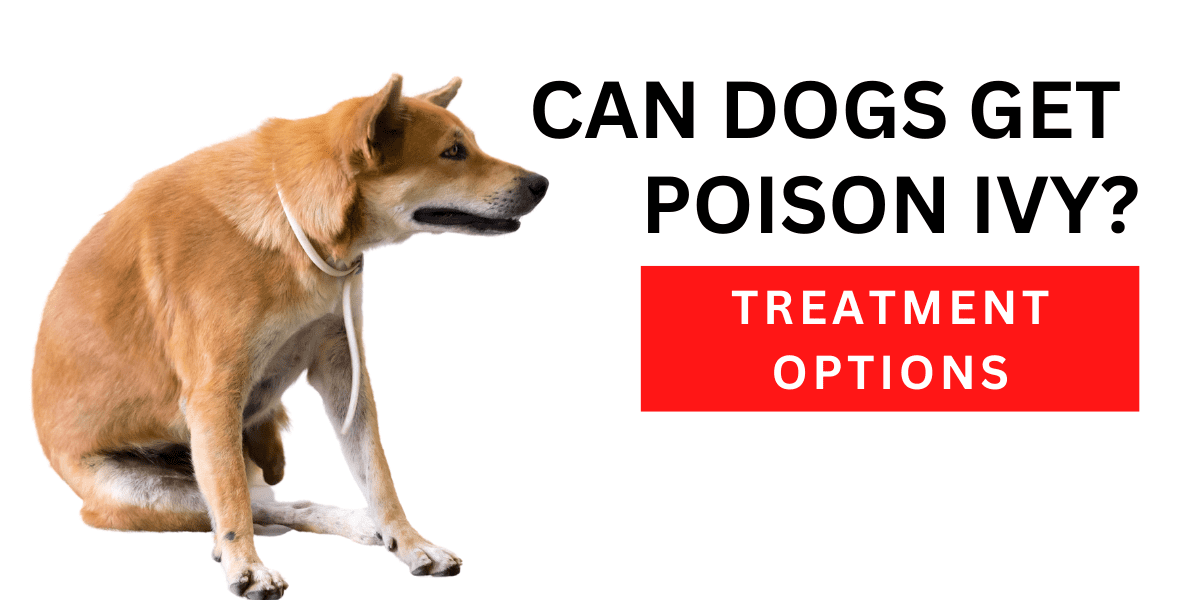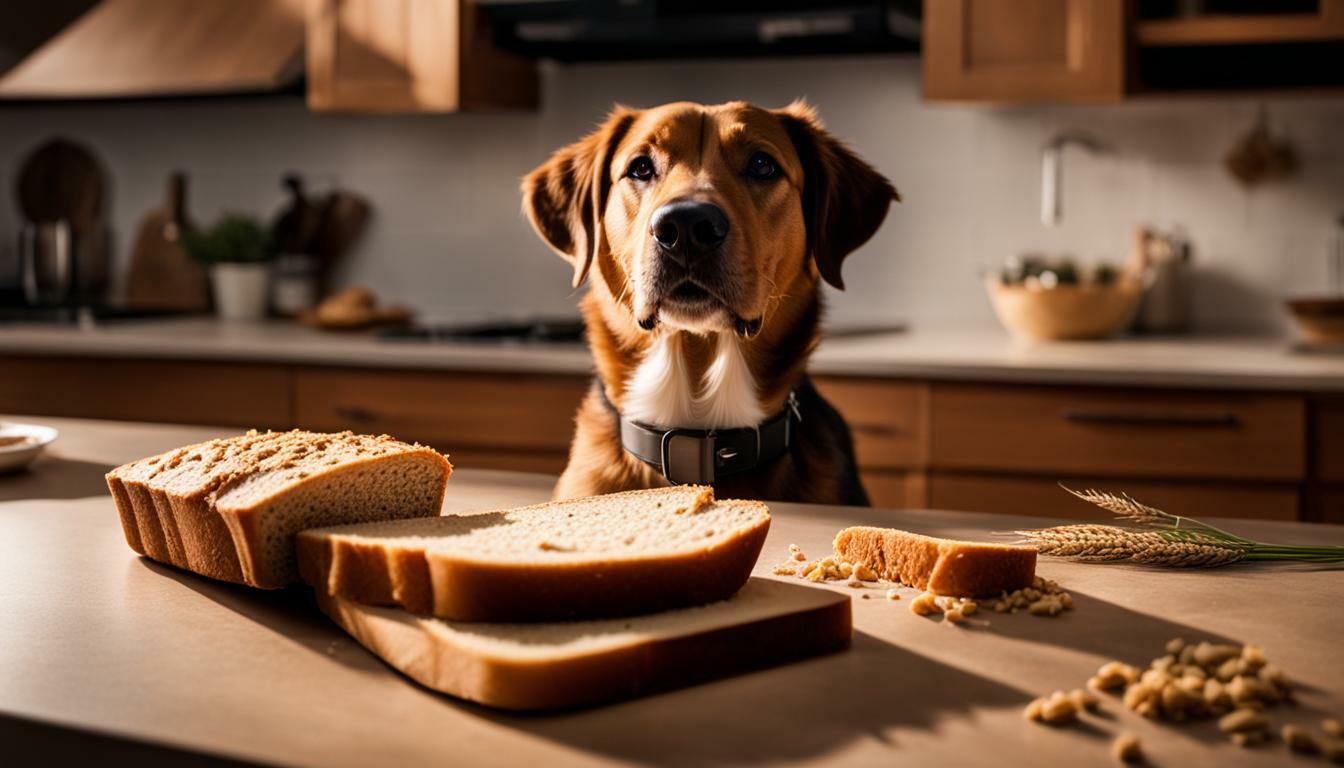
If you’ve ever wondered, “can dogs eat whole wheat bread?” you’re not alone. As a dog owner, it’s crucial to ensure that you’re providing your furry friend with a balanced diet that meets their nutritional requirements.
- Dogs can eat whole wheat bread in moderation, without any additives or toxic ingredients.
- Plain white and wheat bread are generally safe for dogs, as long as they don’t have any allergies.
- Feeding bread to dogs as a treat won’t harm them, but it doesn’t provide any additional nutrients to their diet.
- Bread dough can be dangerous as it can rise in the stomach and release toxic levels of ethanol into the bloodstream.
- Some breads may contain raisins, which are highly toxic to dogs, as well as garlic, nuts, and seeds which can cause stomach irritation or pancreatitis.
If you decide to share bread or baked goods with your dog, it’s important to be cautious and check the ingredients. Avoid breads that contain toxic ingredients like raisins, garlic, nuts, or seeds. Also, be aware that xylitol, an artificial sweetener found in certain baked goods, is toxic to dogs.
Understanding Canine Nutrition
Dogs have specific dietary needs that differ from humans, and it’s vital to understand these requirements to keep them healthy and happy. Just like humans, dogs require a balanced diet to thrive, but their nutritional needs are unique to their species. A proper canine diet consists of essential nutrients that support their overall health.
One of the key differences between human and canine nutrition is the protein requirement. Dogs are primarily carnivorous animals and need a higher protein intake compared to humans. Protein-rich food sources such as meat, fish, and eggs are essential for dogs as they provide the necessary amino acids for muscle development and repair.
In addition to protein, dogs also need a balanced mix of carbohydrates, fats, vitamins, and minerals. Carbohydrates provide energy, while fats play a crucial role in hormone production and maintaining healthy skin and coat. It’s important to note that not all carbohydrates are suitable for dogs, as some may cause digestive issues or allergies. A vet-approved and balanced diet should include high-quality carbohydrates such as whole grains or vegetables.
| Nutrient | Role in Canine Nutrition | Food Sources |
|---|---|---|
| Protein | Supports muscle development and repair | Meat, fish, eggs, legumes |
| Carbohydrates | Provides energy | Whole grains, vegetables |
| Fats | Aids hormone production and maintains healthy skin and coat | Fish oil, flaxseed oil, animal fat |
| Vitamins and Minerals | Support various bodily functions | Fruits, vegetables, supplements |
Understanding canine nutrition is crucial for pet owners to make informed choices about their dogs’ diet. By providing a well-balanced and species-appropriate diet, we can ensure that our furry friends receive the nutrients they need to lead healthy and happy lives.
The Safety of Whole Wheat Bread for Dogs
Whole wheat bread can be given to dogs, but it’s essential to be cautious and understand the potential risks involved. While plain white and wheat bread are generally safe for dogs, it’s important to ensure that the bread doesn’t contain any additives or toxic ingredients. Feeding bread to dogs as an occasional treat won’t harm them, but it’s important to note that bread doesn’t provide any additional nutrients to their diet.
There are a few risks associated with feeding bread to dogs that pet owners should be aware of. One potential danger is bread dough. When ingested, the dough can expand in the stomach, causing discomfort and potentially leading to a life-threatening condition called gastric dilatation-volvulus. Additionally, bread may contain toxic ingredients such as raisins, garlic, nuts, and seeds, which can be harmful to dogs. It is crucial to check the ingredients before sharing bread or baked goods with our furry friends.
It’s important to note that xylitol, an artificial sweetener, is toxic to dogs and can be found in certain baked goods. Even small amounts of xylitol can cause a rapid drop in blood sugar and can lead to liver failure. Therefore, it’s crucial to be cautious and double-check whether xylitol is present in any bread or baked products before offering them to your dog as a treat.
In conclusion, while whole wheat bread can be given to dogs as an occasional treat, it’s essential to exercise caution and ensure that it doesn’t contain any harmful additives or toxic ingredients. Always check the ingredients list and avoid giving bread that contains raisins, garlic, nuts, seeds, or xylitol. Remember, moderation is key when it comes to sharing bread or any human food with our furry companions.
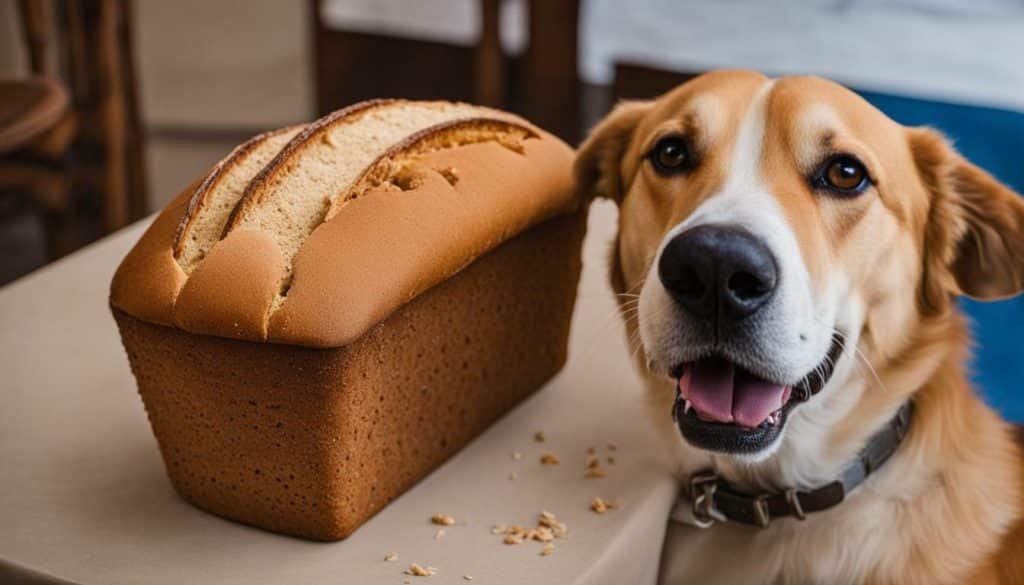
While bread may seem harmless, there are certain risks that dog owners should be aware of when considering sharing this human food with their pets. It’s important to understand these potential dangers to ensure the well-being of our furry friends.
One significant risk is the potential for bread dough to rise in a dog’s stomach. When ingested, the warm and moist environment of the stomach can cause the dough to expand, leading to abdominal discomfort and potentially life-threatening complications. As the dough rises, it produces ethanol, which can be absorbed into the bloodstream and result in alcohol poisoning for dogs.
Another concern is the presence of toxic ingredients in bread. Some varieties of bread may contain raisins, which are highly toxic to dogs and can cause kidney failure. Additionally, certain breads may contain garlic, nuts, or seeds that can cause stomach irritation or even pancreatitis in dogs. It’s important to check the ingredients list carefully before sharing bread with your canine companion.
One commonly overlooked danger is the presence of artificial sweeteners, such as xylitol, in baked goods. Xylitol is highly toxic to dogs and can lead to a rapid drop in blood sugar levels, liver failure, and even death. It’s crucial to be vigilant and ensure that any bread or baked goods you offer your dog do not contain this harmful sweetener.
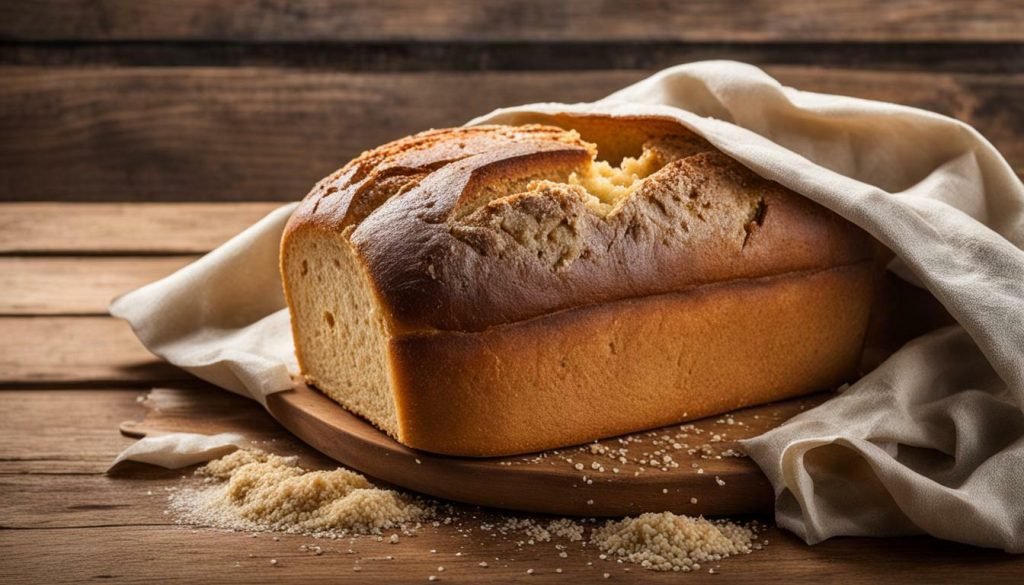
| Potential Risks of Feeding Bread to Dogs | Preventive Measures |
|---|---|
| Bread dough rising in the stomach, releasing toxic levels of ethanol | Avoid feeding dogs bread dough altogether |
| Potential presence of toxic ingredients like raisins, garlic, nuts, or seeds | Check the ingredients list carefully and only offer bread without these components |
| Ingestion of artificial sweeteners like xylitol, which can be found in some baked goods | Always double-check ingredient labels and avoid bread or baked goods that contain xylitol |
To ensure the safety of your dog, it’s essential to exercise caution when it comes to sharing bread or baked goods with them. While the occasional small piece of plain bread may not cause harm, it’s crucial to avoid bread with potentially harmful ingredients and to pay attention to the portion size. Remember, bread should only complement a dog’s balanced and species-appropriate diet rather than serve as a significant portion of it.
Understanding the Impact on Canine Health
Feeding bread to dogs, including whole wheat bread, should be done in moderation to avoid potential health issues. While bread can be a tempting treat for our furry friends, it should not make up a significant portion of their diet. Dogs have specific nutritional needs that are best met by a balanced and species-appropriate diet.
“A properly balanced diet is crucial for a dog’s overall health and well-being,” says Dr. Rachel Thompson, a veterinarian specializing in canine nutrition. “While bread can provide some carbohydrates, it doesn’t offer the essential nutrients, such as protein and vitamins, that dogs require in their diet.”
Obesity-related diseases are becoming increasingly common in dogs, and bread can contribute to weight gain if consumed in large quantities. It’s important to remember that dogs have different caloric needs than humans, and excessive bread consumption can lead to an imbalance in their diet. Instead, treats specifically formulated for dogs, such as commercially available dog biscuits, are a better option for rewarding your furry friend.
| Key Points: | |
|---|---|
| Bread is high in carbohydrates but lacks essential nutrients for dogs. | |
| Excessive bread consumption can contribute to obesity-related diseases in dogs. | |
| Treats specifically formulated for dogs are a better option for rewarding your furry friend. |
“While it may be tempting to share our food with our dogs, it’s important to prioritize their nutritional needs and health,” adds Dr. Thompson. “Feeding bread should be done sparingly and with caution, as certain ingredients and additives found in bread can be harmful or toxic to dogs.”
It’s crucial to be mindful of the ingredients in bread before sharing it with your dog. Some breads may contain raisins, which are highly toxic to dogs and can cause kidney failure. Garlic, nuts, and seeds can also irritate a dog’s stomach or even lead to more severe conditions like pancreatitis. Additionally, certain baked goods may contain xylitol, an artificial sweetener that is toxic to dogs.
Feeding your furry friend plain white or wheat bread without any additives or toxic ingredients, in small amounts, is generally safe. However, it’s always best to consult with your veterinarian before introducing any new foods into your dog’s diet. They can provide personalized advice based on your dog’s specific needs and health conditions.
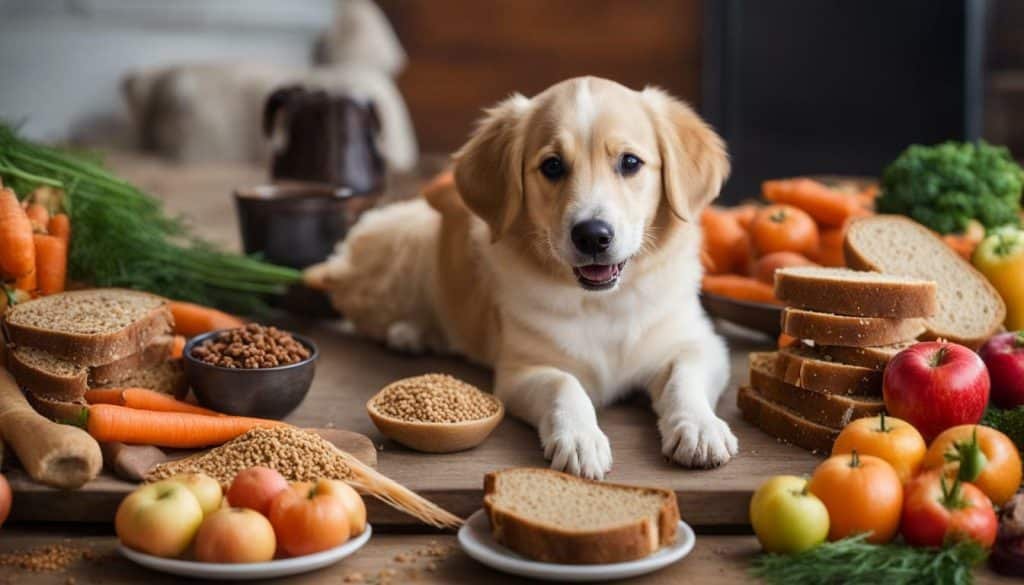
In summary, while dogs can eat whole wheat bread, it should be given in moderation and without any additives or toxic ingredients. Bread should never make up a significant portion of a dog’s diet, as it does not offer the essential nutrients they need. Feeding bread and other human foods to dogs should always be done with caution, and it’s important to prioritize their specific nutritional needs and overall health.
Toast and its Safety for Dogs
If you enjoy a crunchy toast in the morning, your dog may also show interest, but it’s important to understand the potential risks and limitations of sharing this breakfast staple with them. Plain toast without butter is generally safe for dogs to eat in moderation. However, it’s essential to consider certain factors to ensure your furry friend’s well-being.
Toast can be a simple and enjoyable treat for dogs. It provides a satisfying crunch and can be a source of carbohydrates. But it’s important to remember that dogs have different dietary needs than humans, and their diet should primarily consist of nutritionally balanced dog food.
While plain toast is generally safe for dogs, it’s important to avoid giving them toast with butter. Butter is high in fat and can lead to weight gain and pancreatitis in dogs. Too much fat in a dog’s diet can cause digestive upset and potentially serious health issues. So, it’s best to stick to plain, unbuttered toast and offer it as an occasional treat rather than a regular part of their diet.
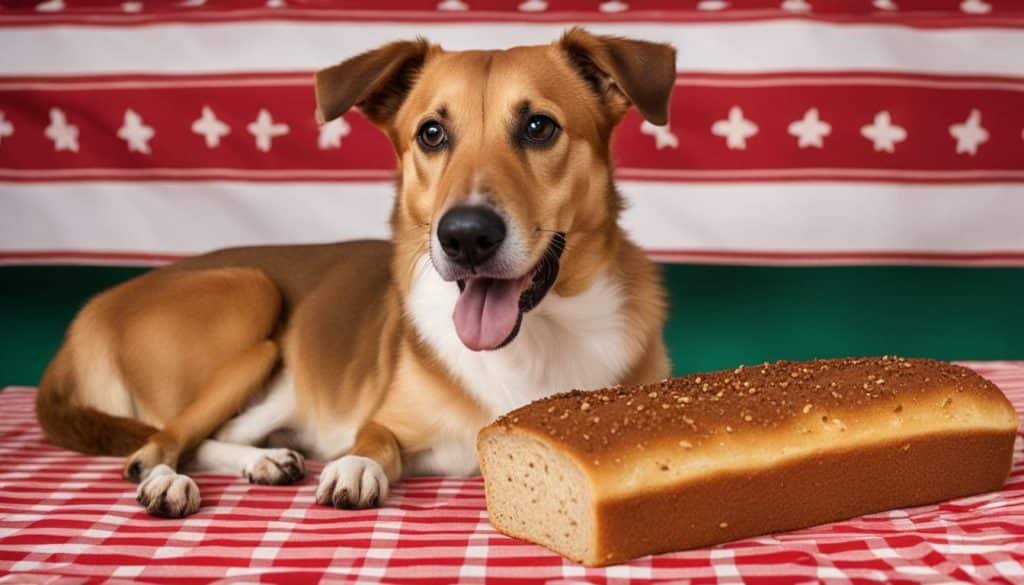
Toast can provide a satisfying texture and can be a source of carbohydrates for dogs. However, it’s important to note that dogs primarily rely on protein for their energy needs. While toast may be a tasty snack, it doesn’t offer any additional essential nutrients that dogs need.
Feeding your dog small portions of plain, unbuttered toast can be a way to provide them with a little variety in their diet and offer them a special treat. As with any food given to dogs, moderation is key to prevent any potential digestive issues or weight gain.
| Potential Risks of Feeding Toast to Dogs |
|---|
| 1. High fat content in butter can lead to weight gain and pancreatitis. |
| 2. Toast should not be a significant part of a dog’s diet as it lacks essential nutrients. |
| 3. Excessive consumption of toast can cause digestive upset. |
| 4. Always ensure the toast is plain and does not contain any toxic ingredients or additives. |
“While plain toast is generally safe for dogs, it’s important to avoid giving them toast with butter. Butter is high in fat and can lead to weight gain and pancreatitis in dogs.”
Remember, every dog is unique, and it’s always a good idea to consult with your veterinarian before introducing any new foods into their diet. They can provide tailored advice based on your dog’s specific needs and ensure their nutritional requirements are being met.
Wholemeal Bread and its Suitability for Dogs
If you’re considering offering your dog wholemeal bread as a treat, it’s crucial to understand what to look for and what to avoid. Wholemeal bread can be a suitable option for dogs, as it contains more fiber and nutrients compared to white bread. However, it’s important to ensure that the bread doesn’t contain any seeds, nuts, or fruits, which can be harmful to dogs.
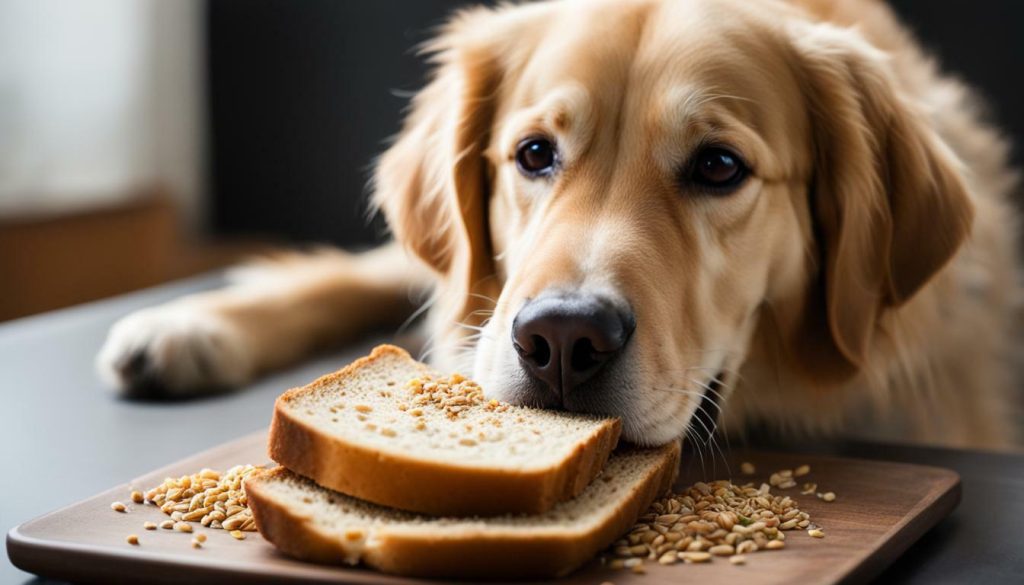
When choosing wholemeal bread for your furry friend, always check the ingredients list to ensure it’s free from any potentially toxic additions. It’s best to opt for plain wholemeal bread without any additives or preservatives. Dogs have different dietary needs than humans, so it’s crucial to avoid breads that include harmful ingredients such as raisins, garlic, or artificial sweeteners like xylitol.
Feeding wholemeal bread to your dog in moderation can provide them with a small amount of carbohydrates and dietary fiber. However, it’s important to remember that bread should never make up a significant portion of their diet. Dogs require a balanced and species-appropriate diet to ensure their overall health and well-being. While wholemeal bread can be a safe occasional treat for dogs, it’s essential to consult your veterinarian to determine the best dietary plan for your furry friend.
| Pros of Wholemeal Bread for Dogs | Cons of Wholemeal Bread for Dogs |
|---|---|
|
|
Remember, before introducing any new food into your dog’s diet, it’s always best to consult with your veterinarian to ensure it aligns with their specific nutritional needs. By providing a balanced and appropriate diet, you can help keep your beloved companion happy and healthy for years to come.
References:
- “Can Dogs Eat Bread? What to Know About Dogs and Bread” – American Kennel Club
- “Garlic” – ASPCA Animal Poison Control Center
- “Toxic Foods and Your Dog” – VCA Animal Hospitals
Bread as a Nutritional Supplement for Dogs
While dogs can eat whole wheat bread, it’s important to note that it should not replace a balanced and complete diet that meets their nutritional requirements. Bread can provide some carbohydrates to a dog’s diet, but it lacks the essential nutrients that dogs need to thrive. It should be given sparingly and in moderation, as an occasional treat rather than a staple food.
Feeding bread to dogs may not provide any additional nutritional benefits, but it can still be enjoyed as an occasional snack. It’s crucial to ensure that the bread given to dogs is plain and free from any additives or toxic ingredients. Always check the ingredients list to avoid potential dangers like raisins, garlic, nuts, seeds, or artificial sweeteners like xylitol.
Table: Nutritional Comparison of Whole Wheat Bread and Dog Food
| Nutrients | Whole Wheat Bread (1 slice) | Dog Food (1 serving) |
|---|---|---|
| Protein | 3g | Varies based on brand and formula |
| Fat | 1g | Varies based on brand and formula |
| Carbohydrates | 15g | Varies based on brand and formula |
| Fiber | 2g | Varies based on brand and formula |
| Vitamins and Minerals | Minimal | Formulated to meet a dog’s nutrient requirements |
It’s crucial to remember that every dog is different, and some dogs may have specific dietary restrictions or allergies. Consult with a veterinarian before introducing any new foods or treats into your dog’s diet to ensure their safety and well-being.
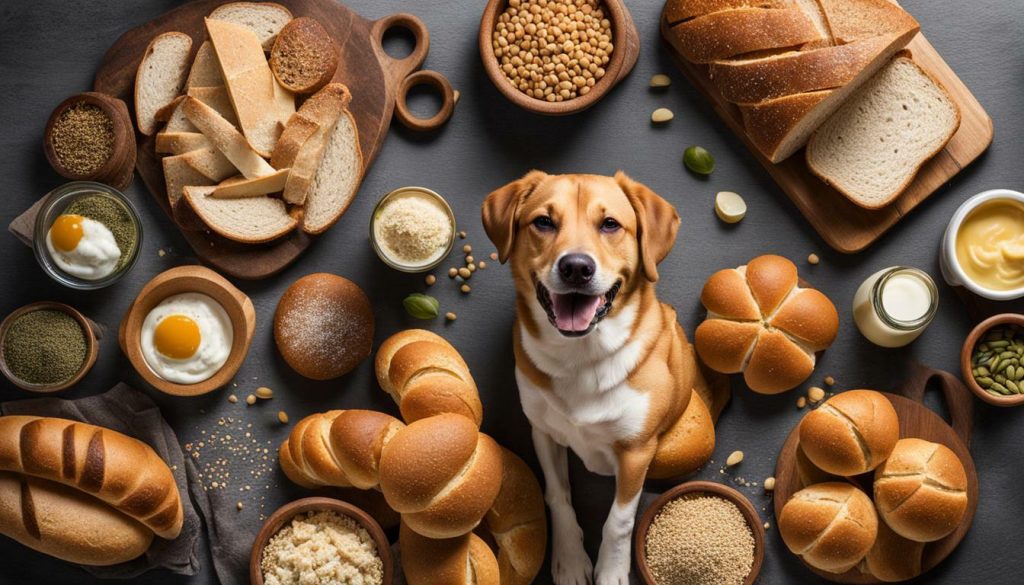
Just like with any other human food, it’s crucial to offer bread to dogs in moderation and ensure it doesn’t become a significant part of their daily intake. While bread can be enjoyed by dogs as an occasional treat, it should not replace their regular balanced diet. Dogs have specific nutritional needs that are best met through a balanced and species-appropriate diet.
Feeding bread to dogs in excess can lead to weight gain and obesity-related diseases. It’s important to remember that bread is primarily made up of carbohydrates and lacks the essential nutrients that dogs require. Instead, focus on providing your furry friend with a diet that includes high-quality dog food specifically formulated to meet their nutritional needs.
To ensure moderation and portion control, consider giving your dog small pieces of plain white or whole wheat bread as a special reward during training sessions or as an occasional snack. Avoid giving them bread with any additives or toxic ingredients, such as raisins, garlic, nuts, or seeds. Always read the ingredient list carefully before sharing bread or baked goods with your canine companion.
Remember, dogs have unique dietary restrictions, and certain foods can be harmful to their health. If you notice any adverse reactions or unusual behavior after your dog consumes bread, consult your veterinarian for guidance. They can provide personalized advice based on your dog’s individual needs and help you create a balanced diet plan that ensures their overall well-being.
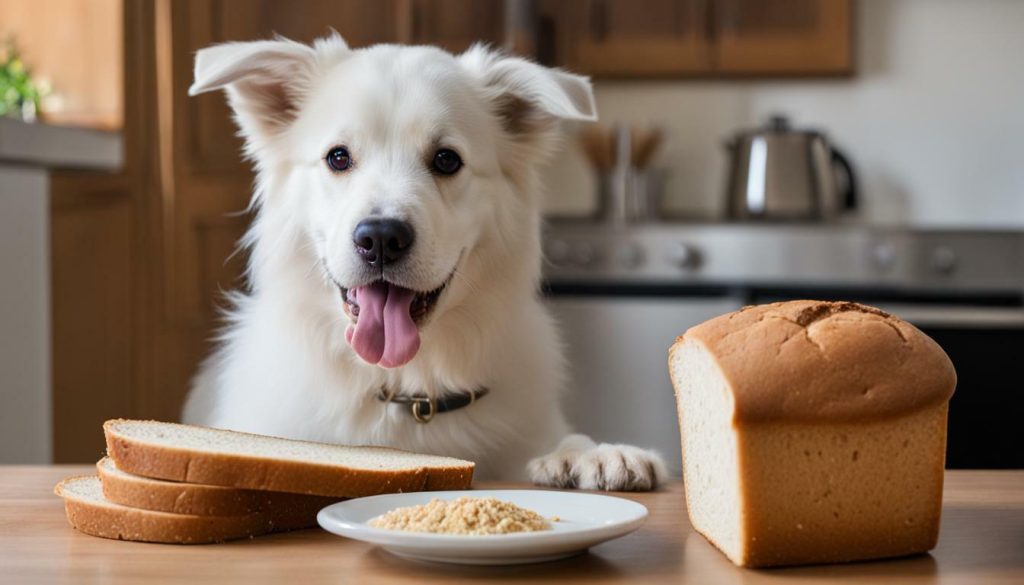
| Benefits of Offering Bread in Moderation | Considerations and Risks |
|---|---|
|
|
The Importance of Checking Ingredients
Before offering your furry friend a piece of bread, it’s important to carefully examine the ingredients to ensure their safety and well-being. While bread might seem like a harmless treat, it can contain ingredients that are toxic to dogs. Taking the time to read the ingredient list can help you avoid any potential risks and keep your canine companion healthy.
One common ingredient to watch out for is raisins, which are highly toxic to dogs. Even a small amount can lead to kidney failure and other serious health issues. Additionally, breads that contain garlic, nuts, or seeds can cause stomach irritation or even pancreatitis in dogs. It’s essential to avoid these ingredients to prevent any adverse reactions.

Another harmful ingredient to be aware of is xylitol, an artificial sweetener found in some baked goods. Xylitol is highly toxic to dogs and can cause a rapid and severe drop in blood sugar levels, leading to liver failure and other complications. Always double-check the labels for this harmful substance.
To ensure your dog’s well-being, it’s crucial to stick to plain white or whole wheat bread without any additives or toxic ingredients. Make sure the bread you offer to your dog is free from harmful substances, and always feed it in moderation. Remember that bread should only be given as an occasional treat and should never replace a balanced and species-appropriate diet for your furry friend.
Conclusion
In conclusion, dogs can eat whole wheat bread, but it should only be given in moderation and without any toxic or harmful ingredients. Plain white and wheat bread are generally safe for dogs, as long as they don’t have any allergies.
Feeding bread to dogs as a treat won’t harm them, but it doesn’t provide any additional nutrients to their diet. While bread can serve as a source of carbohydrates, it doesn’t offer the essential nutrients that dogs need to thrive.
However, there are risks associated with feeding bread to dogs. Bread dough can be dangerous as it can rise in the stomach and release toxic levels of ethanol into the bloodstream. Certain breads may also contain raisins, which are highly toxic to dogs. Additionally, ingredients like garlic, nuts, and seeds can cause stomach irritation or even pancreatitis in dogs.
Xylitol, an artificial sweetener, is also toxic to dogs and can be found in some baked goods. It’s crucial for dog owners to be cautious and check the ingredients before sharing any bread or baked goods with their pets.
Toast is generally safe for dogs to eat in moderation, but it’s important to avoid toast with butter due to its high fat content. Garlic bread should never be fed to dogs, as garlic is toxic to them.
If considering wholemeal bread, it can be safely given to dogs as long as it doesn’t contain any seeds, nuts, or fruits that may be harmful to them.
Overall, it’s important to remember that bread should be given sparingly and should not make up a significant portion of a dog’s diet. Feeding dogs a balanced and species-appropriate diet is crucial for their overall health and well-being, and bread should be considered as an occasional treat rather than a regular part of their meals.
FAQ
Can dogs eat whole wheat bread?
Yes, dogs can eat whole wheat bread in moderation, as long as it doesn’t contain any additives or toxic ingredients. Plain white and wheat bread are generally safe for dogs, as long as they don’t have any allergies. However, bread should not make up a significant portion of a dog’s diet and should only be given as an occasional treat.
What are the risks associated with feeding bread to dogs?
There are a few risks associated with feeding bread to dogs. Bread dough can be dangerous as it can rise in the stomach and release toxic levels of ethanol into the bloodstream. Some breads may contain raisins, which are highly toxic to dogs, as well as garlic, nuts, and seeds which can cause stomach irritation or pancreatitis. Additionally, xylitol, an artificial sweetener, is toxic to dogs and can be found in certain baked goods. It’s important to be cautious and check the ingredients before sharing bread or baked goods with dogs.
Is toast safe for dogs?
Yes, plain toast without butter is generally safe for dogs to eat in moderation. However, caution should be taken due to the high fat content in butter, which is not recommended for dogs. Toast should only be given as an occasional treat and not as a regular part of a dog’s diet.
Can dogs eat wholemeal bread?
Yes, dogs can safely eat wholemeal bread, as long as it doesn’t contain any seeds, nuts, or fruits. Wholemeal bread can be given to dogs in moderation, but it should not make up a significant portion of their diet.
Is bread a nutritional supplement for dogs?
While bread may provide some carbohydrates, it doesn’t offer additional essential nutrients that dogs need in their diet. Feeding bread to dogs won’t harm them, but it doesn’t provide any significant nutritional benefits either. It’s important to ensure dogs receive a balanced and species-appropriate diet to meet their nutritional needs.
How much bread should I give to my dog?
Bread should only make up a small portion of a dog’s diet. It should be given in moderation as an occasional treat, rather than a regular food item. It’s important to consider a dog’s overall diet and ensure they are receiving all the essential nutrients they need from their main meals.
Should I check the ingredients in bread before giving it to my dog?
Yes, it’s important to check the ingredients in bread before sharing it with your dog. Some breads may contain toxic ingredients like raisins, garlic, nuts, or seeds, which can be harmful to dogs. Additionally, certain baked goods may contain xylitol, an artificial sweetener that is toxic to dogs. To keep your dog safe, always read the ingredient list and avoid any potentially harmful ingredients.


